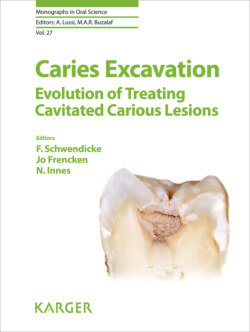Читать книгу Caries Excavation: Evolution of Treating Cavitated Carious Lesions - Группа авторов - Страница 40
На сайте Литреса книга снята с продажи.
Radiography
ОглавлениеIn order to enhance the detection of approximal carious lesions on bitewing, radiography is usually recommended. This technique allows the visualisation of the demineralisation depth both in enamel and in dentine. For dental practitioners, bitewing radiography is the primary means of supplementing findings obtained by visual inspection. Bitewing radiography shows mineral loss by change of radiolucency. It should be kept in mind that the change of radiolucency is a mere estimate for the degree of demineralisation. It does not show if active biofilm is present and thus if the lesion is progressing or is in a stagnating phase. Only the comparison with previous or future radiographs allows for lesion activity judgement. It is not possible to see on a bitewing radiograph whether the surface is cavitated or not [33]. There is too much overlap of dental hard tissue both in occlusal and approximal surfaces that does not allow the determination of whether cavitation has already occurred in the outermost surface. In a recent meta-analysis, sensitivity and specificity for carious lesion detection in approximal surfaces have been reported to be 0.36 and 0.94, respectively, at the dentine level [34]. When enamel carious lesions are included, sensitivities and specificities changed to 0.24 and 0.97 [34].
Because dental radiography consists of ionising radiation, its use should be justified [35]. Practically all dental scientific societies have published regulations on the frequency for bitewing radiographs, depending on the individual caries risk and on the age of the patient [35–38].
Depending on the detection threshold, bitewing radiography can be both helpful and misleading. It has been shown that if enamel carious lesions are included in the detection threshold level, more enamel lesions can be detected visually than radiographically [19, 20]. This might be because the crowns should be free from overlapping structures on the radiograph for superficial enamel carious lesion detection. Crowding of teeth, height of the palate, compliance of the patient and positioning of the intraoral film can reduce the quality of the radiographs, resulting in less diagnostic information for the dentist. When the caries prevalence is low, the possible risk of false-positive diagnoses outweighs the risk of overlooked carious lesions [3].
Several clinical studies have been carried out to assess the state of the surface in relation to depth of radiolucency in bitewing radiographs (for a review see Wenzel [33]). If dentinal carious lesions are visible in approximal surfaces, the surface has been found to be broken in earlier studies in more than 70% of cases [33].
If occlusal dentinal carious lesions are visible radiographically on otherwise clinically inconspicuous occlusal surfaces, the clinician should be aware of ongoing demineralisation, and a minimally invasive restoration should be applied [22]. However, it is not possible to see occlusal carious lesions restricted to enamel in bitewing radiographs.
As a more recent development, cone beam computerised tomography (CBCT) has been advocated by some authors who reported that a higher sensitivity with unchanged specificity might be achieved in vitro [39–41]. Under optimum circumstances, with high resolution, crowns without restorations can be viewed with CBCT almost as well as with microcomputed tomography, and it might be possible to even detect a cavitation in the transverse plane. However, since most devices have a limited field of view, one CBCT scan would be necessary for each side. Taking this into account and the fact that CBCT images are compromised by radiation artefacts from existing fillings or even from thick enamel [42], the much higher radiation dose, costs, and, last but not least, the necessity to interpret all radiologic findings for legal reasons [43], CBCT cannot be regarded as a recommended means for caries lesion detection. It is safe to stipulate that for caries detection, CBCTs absolutely cannot be justified.
